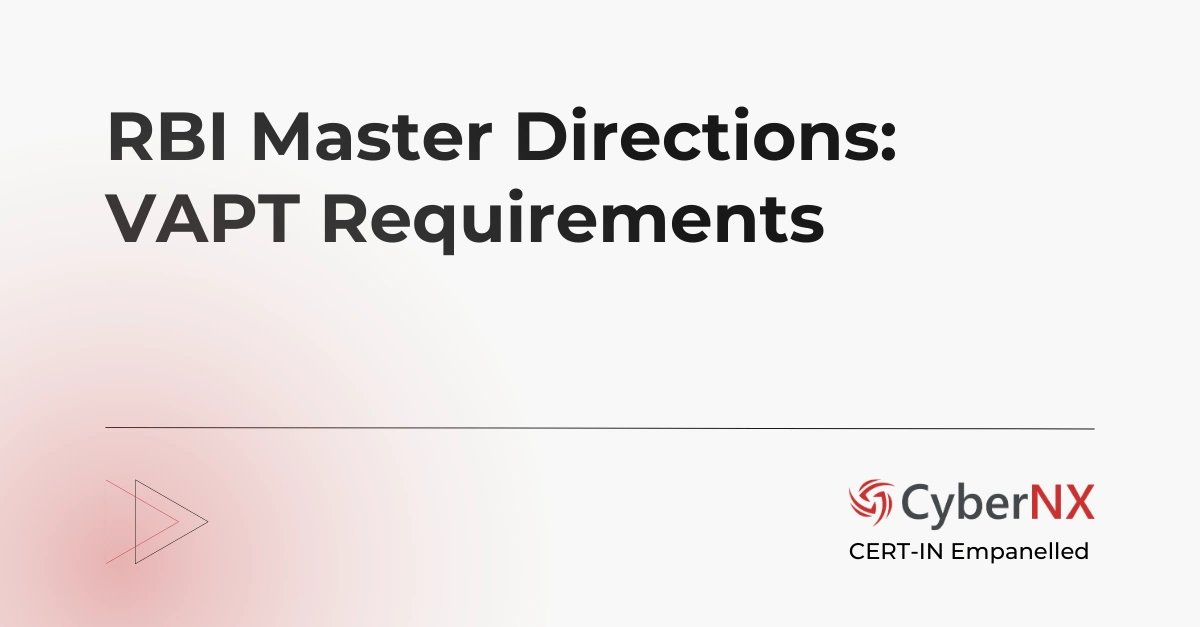NBFCs are dealing with changing expectations around technology, risk and cyber resilience. The latest RBI Master Directions for NBFCs bring clarity as well as pressure. Boards must take deeper ownership. CISOs need more independence. Technology teams must run tighter controls. Vendors must be assessed more rigorously.
This RBI Master Directions gap assessment checklist helps NBFCs understand where they stand. It simplifies the new mandates and turns them into practical checks. Our aim is simple. Help leadership teams build confidence, prepare early and reduce surprises during supervisory reviews.
Understanding the RBI Master Directions for NBFCs
The RBI Master Directions for NBFCs set mandatory standards for IT governance, information security, cyber resilience, disaster recovery and vendor oversight. These mandates apply to NBFCs in the top, upper and middle layers.
They define clear expectations for:
- Board responsibilities
- Structure and authority of the IT Strategy Committee
- CISO independence
- Testing and assurance activities
- Third party and vendor risk
- Business continuity and recovery
- Data security and monitoring
We meet many NBFC teams each year. The pattern is clear. Most leaders know the intent behind the directions. The challenge is turning them into daily practices that work under pressure. That is where a gap assessment becomes invaluable.
RBI Master Direction gap assessment checklist for NBFCs
Below is a comprehensive checklist. Use this to identify gaps, create a remediation roadmap and plan your compliance strategy.
1. Board oversight and governance
The directions place strong emphasis on the role of the Board. They expect leadership to approve strategies, review policies and maintain clear visibility on technology and cyber risks.
Key checks
- Does the Board approve the IT, information security and cyber security strategy
- Does the Board conduct an annual review of all technology and cyber related policies
- Does the Board receive quarterly updates on cyber risks
- Has the NBFC formally defined the Board’s responsibilities in technology oversight
These steps give clarity. They help leadership teams work with confidence. They also ensure that security decisions get the right attention.
2. IT Strategy Committee structure and responsibilities
The IT Strategy Committee is expected to bring direction and stability to technology planning. The committee must include individuals with relevant experience. The person leading the committee must have strong exposure to technology.
Key checks
- Is the Committee formed with the right senior members
- Does the chairperson have seven years of relevant IT experience
- Does the Committee meet quarterly
- Are meeting minutes documented
- Is the IT budget aligned with digital initiatives and risk exposure
When an NBFC gets this right, technology decisions become sharper. Budgets match priorities. Teams gain direction.
3. CISO independence and authority
The CISO plays a central role in cyber resilience. The RBI Master Directions for NBFCs require the CISO to report independently of the technology operations team. This structure supports objectivity and ensures that risk concerns are raised without conflict.
Key checks
- Does the CISO report to the Executive Director or equivalent who manages risk
- Is the CISO independent of the technology operations team
- Does the CISO present cyber resilience updates every quarter
- Does the CISO have authority to escalate issues without restriction
Our experience shows that this is the area where many NBFCs struggle. Fixing reporting lines takes planning. But once done, the benefits are immediate. Risk gets recognised earlier. Issues do not get buried.
4. Vulnerability assessment and penetration testing
Vulnerability assessment and penetration testing activities are essential in the RBI Master Directions for NBFCs. They ensure that weaknesses are identified quickly.
Key checks
- Are vulnerability assessments carried out at least once every six months
- Are penetration tests carried out at least once a year for critical systems
- Are VA and PT reports tracked
- Are remediation actions defined with timelines
- Are closure updates shared with senior management
NBFCs often run the tests but do not track remediation effectively. The checklist helps to close that gap.
5. Disaster recovery planning and testing
The Direction expects DR drills at least twice a year for critical systems. Recovery objectives must be short. Configurations at primary and DR sites must match.
Key checks
- Are half yearly DR drills conducted
- Are RTO and RPO defined in simple, measurable terms
- Are the RPO values near zero for critical systems
- Are configurations at DC and DR identical
- Are drill results reviewed by senior management
A strong DR programme gives peace of mind. Systems fail. Incidents happen. What matters is how fast you bounce back.
6. Third party and vendor risk management
NBFCs rely on vendors for applications, platforms and operational support. The directions require structured vendor assessment, source code access or escrow for critical applications and clear visibility into concentration risks.
Key checks
- Is a formal vendor risk assessment process in place
- Do critical applications have source code access or escrow arrangements
- Are vendors evaluated for concentration risk
- Are incident reporting requirements defined for all vendors
- Are contracts updated with cyber security clauses
Many NBFCs underestimate vendor dependency. A single vendor outage can pause an entire line of business. Strengthening vendor risk controls is central to resilience.
7. Change management and patching control
The Direction highlights the importance of consistent configurations and well governed changes. Critical systems must remain stable. Changes must follow a controlled path.
Key checks
- Is there a formal change management process
- Are emergency changes documented
- Are critical systems patched within defined timelines
- Are configurations of critical systems monitored regularly
When patching improves, risk reduces. Most breaches still exploit known vulnerabilities.
8. Data protection and monitoring controls
Data sits at the heart of NBFC operations. The directions expect strong access controls, monitoring and classification measures.
Key checks
- Is there a clear data classification policy
- Are access rights reviewed at least every quarter
- Are privileged users monitored
- Are logs retained as per policy
- Are alerts escalated without delay
These checks help NBFCs build assurance. Strong data controls also build customer trust.
9. Cyber incident management
Incident management remains a core requirement. The directions expect NBFCs to have clear escalation paths, defined roles and documented plans.
Key checks
- Is there an approved cyber incident response plan
- Are roles, escalation paths and thresholds defined
- Are tabletop exercises conducted
- Are incidents reviewed for lessons learned
We have seen simple tabletop exercises transform team readiness. They reveal gaps that stay hidden in documents.
10. Policy framework completeness
NBFCs maintain numerous policies across IT and cyber domains. These documents must stay updated, approved and aligned to the directions.
Key checks
- Is there a full policy inventory
- Are policies updated at least once a year
- Are policies approved by the appropriate authority
- Are employees trained on policy changes
A well-structured policy framework supports audit readiness and reduces ambiguity.
11. Internal audit and assurance
Internal audit plays a major role in validating adherence to the RBI Master Directions for NBFCs.
Key checks
- Is there an annual assurance plan
- Are audits of IT and cyber functions scheduled
- Are findings tracked to closure
- Are reports shared with the Board or committee
Clear audit trails demonstrate commitment and preparedness.
How NBFCs can use this checklist
This RBI Master Directions gap assessment checklist serves as a reference point. It helps NBFCs reflect on their current environment and understand where the Directions create the greatest impact. It also supports strategic planning. When leaders view these areas collectively, they develop a clearer sense of their organisation’s resilience and operational readiness.
Conclusion
The RBI Master Directions gap assessment checklist set a high benchmark for governance, cyber resilience and continuity. Following them strengthens more than compliance. It improves trust. It builds confidence. It reduces uncertainty. Every NBFC can reach this level with a clear checklist and a structured plan.
If your organisation needs help with the gap assessment or roadmap preparation, we are here to support you with our RBI Master Direction Compliance services. We work alongside your teams and help you build resilient systems that grow with your business.
RBI Master Directions for NBFCs FAQs
What areas usually show the largest gaps when NBFCs review their posture against the RBI Master Directions for NBFCs?
Many NBFCs find gaps in vendor oversight, DR readiness and configuration consistency. These areas often involve multiple teams and dependencies, which can delay improvements.
How does CISO independence influence alignment with the RBI Master Directions for NBFCs?
Independence strengthens objectivity. It allows the CISO to surface risks openly and present a realistic view of the organisation’s cyber resilience. This improves decision making at senior levels.
Are smaller NBFCs affected by the RBI Master Directions for NBFCs?
The expectations apply primarily to NBFCs in the top, upper and middle layers. However, smaller NBFCs often adopt many of the controls voluntarily because they improve resilience and customer confidence.
What role does disaster recovery testing play in meeting the RBI Master Directions for NBFCs?
DR testing demonstrates the organisation’s ability to maintain continuity. It helps identify misconfigurations, dependency issues and gaps in operational readiness. It also provides leadership with evidence of preparedness.





